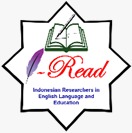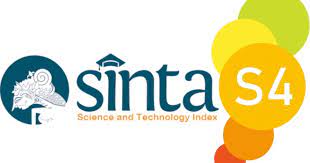Path Analysis on Writing Anxiety, Writing Attitude, Language Awareness, and Writing Achievement of University Students
DOI:
https://doi.org/10.22219/englie.v3i1.19657Keywords:
language awareness, writing achievement, writing anxiety, writing attitudeAbstract
During the teaching and learning process in writing context, EFL learners have their own intrinsic problems. They tend to experience some psychological tensions such as writing anxiety, writing attitude and language awareness. In line, some academical issues they need to handle in writing context are text organization, grammar, spelling, punctuation and ideas development. The aim was to find out the direct and indirect contribution among the variables. Thus, writing anxiety and writing attitude were the exogenous variable, then language awareness as mediated variable, while the writing achievement as the endogenous variable. This study applied the combination of multiple regression and mediated model as a part of Path Analysis. There were four instruments used, namely SLWAI, ATWQ, LALQ, and TOEFL Independent Writing Test. These instruments were fulfilled by 100 participants of fourth semester English Department students. The data was collected online through Google Form, Google Meet and personal chat on WhatsApp. The result shows that there was low significant direct contribution of writing anxiety toward writing achievement. Meanwhile, there was no significant direct contribution of writing attitude toward writing achievement. In addition, there was a significant direct contribution of language awareness toward writing achievement. Besides, the result of indirect contribution revealed, there was no indirect contribution of writing anxiety through writing attitude toward writing achievement. Then, the indirect contribution of writing attitude through language awareness toward writing achievement was found out significant. Lastly, it was revealed that there was no indirect contribution of writing anxiety through language awareness toward writing achievement.
Downloads
References
Abadikah, S., Aliyan, Z., & Hassan, S. (2018). EFL Students' Attitudes toward Self-Regulated Learning Strategies in Academic Writing. Issues in Educational Research, 1-17.
AlMawarni, M. (2020). Academic Writing Challenges and Potential Solutions. Arab World English Journal (AWEJ), 14-121.
Al-Mukdad, S. (2019). Investigating English Academic Writing Problems Encounters by Arab International University Students. Theory and Practice in Langugae Studies , 301-312.
Astuti, C. W. (2020). Language Awareness: Language Use and Reasons for Code-Switching. A Journal on Language and Language Teaching, XXIII(1), 116-130.
Broek, E. W., Oolbekkink-Marchand, H. W., Kemenade, A. M., Meijer, P. C., & Unsworth, S. (2019). Stimulating Language Awareness in the Foreign Language Classroom: Exploring EFL Teaching Practices. The Language Learning Journal, 1-15.
Broughton, G. (1980). Teaching English as a Foreign Language. New York: Routledge Edition Book.
Brown, H. D. (2000). Teaching by Principles An Interactive Approach to Language Pedagogy (2nd ed.). London: Pearson.
Brown, H. D. (2006). Principle of Language Teaching and Learning (5th ed.). London: Pearson.
Cheng, Y. (2004). Journal of Second Language Writing. Research Gate, XIII, 313-335.
Cheng, Y. (2004). Journal of Second Language Writing. Research Gate, 313-335.
Choy, C. (2015). Learner Awareness Levels Questionnaire: Development and Preliminary Validation of the English and Malay Versions to Measure How and Why Students Learn. Research Gate , 425-429.
Coşkun, G., & Taşgın, A. (2018). An Investigation of Anxiety and Attitudes of University Students towards English Courses. Journal of Language and Linguistic Studies, XIV(2), 135-153.
Daly, J. (1978). Writing apprehension and writing competency. Journal of Educational Research, 10-12.
Erkan, D. Y., & Saban, A. İ. (2011). Writing Performance Relative to Writing Apprehension, Self-Efficacy in Writing, and Attitudes towards Writing: cA Correlational Study in Turkish Tertiary-Level EFL. Asian EFL Journal, XIII(1), 164-192.
Farahian, M., & Raezae, M. (2015). Language Awareness in EFL Context: An Overview. International Journal of Language, Literature and Culture, , 19-23.
Goodine, M. (2021, July 18). TOEFL Independent Writing Master Guide.
Hakim, B. M. (2019). A Study of Language Anxiety among English Language Learners in Saudia Arabia. AWEJ, 64-72.
Holmes, J. (2013). An Introduction to Sociolinguistics (4th ed.). New York: Routledge.
Jawas, U. (2019). Writing Anxiety among Indonesian EFL Students: Factors and Strategies" . International Journal of Instruction, 733-746.
Kadhim, B. H. (2019). The Effect of PAPSA Model on Iraqi EFL University Students‟ Writing Performance and Attitude. International Journal of English Language, Literature in Humanities, 582-610.
Kheirabadi, S. (2018). The Role of Psychology in Teaching English Language as Foreign Language. Humanities, Arts and Literature, XI(5), 167-172.
Kırmızı, Ö., & Kırmızı, D. (2015). An Investigation of L2 Learners’ Writing Self-Efficacy, Writing Anxiety and Its Causes at Higher Education in Turkey. International Journal of Higher Education, IV(2), 57-66.
Kusumaningputri, R., Ningsih, T. A., & Wisasongko. (2018). Secong Language Writing Anxiety of Indonesian EFL Students. Lingua Cultura, XII(4), 357-362.
Lin, Y. (2001). A Language Awareness Approach to English Language Teaching in Joint Programs in China. Proceedings of The 16th Conference of Pan-Pcific Association of Applied Linguistics, 123-128.
Liu, M., & NI, H. (2015). Chinese University EFL Learners' Foreign Language Writing Anxiety; Pattern, EFfect and Causes. English Language Teaching, 46-58.
Miri, M. A., & Joia, J. (2018). Writing Anxiety in an Afghan EFL Setting: Voices From Five Afghan Students. Journal of Foreign Language Teaching & Learning , 14-29.
Morali, G., & Boran, M. (2021). Exploring the Relationship between Writing Anxiety and Writing Self-Efficacy of International Students Learning Turkish as a Aecond Language . Cypriot Journal of Educational Sciences , 2025-2036.
Ong, J. (2015). Do Individual Differences Matter to Learners’ Writing Ability? The Asian Journal of Applied Linguistics, II(2), 129 - 139.
Riehl, C. M. (2021). The Interplay of Language Awareness and Bilingual Writing Abilities in Heritage Language Speakers. Languages, 1-23.
Riyanto, S., & all., e. (2015). The Role of Attitude to Language Learning in Readng Comprehension. Media Neliti Publication, 3-12.
Sarwono, J. (2011). Mengenal Path Analysis: Sejarah, Pengertian Dan Aplikasi. Jurnal Ilmiah Manajemen Bisnis Ukrida, XI(2), 285-296.
Sarwono, J. (2012). Path Analysis dengan SPSS: Teori, Aplikasi, Prosedur Analisis untuk Riset Skripsi, Tesis dan Disertasi. Jakarta: Elex Media Komptindo.
Setyowati, L., & Sukmawan, S. (2019). EFL Indoenesian Students' Attitude toward Writing in English. Arab WOrld English Journal (AWEJ), 365-378.
Sugiyono. (2016). Statistika Untuk Penelitian. Bandung: Penerbit Alfabeta .
Svedberg, A. M. (2007). Language Awareness and Language Learning. Language Teaching, IV(4), 287-308.
Thornbury, S. (2016). An A-Z of ELT. London: Macmillan.
Trang, T. T. (2012). A Review of Horwitz, Horwitz and Cope's Theory of Foreign Language Anxiety and the Challenge of the Theory. Canadian Center of Science and Education, 69-75.
Udu, T. T. (2021). Teachers’ and Students’ Attitudes towards Reading and Writing: Do They Correlate to Students’ Achievement in English? Studies in English Language and Education, 143-156.
van Lier, L. (2001). Language Awareness: The Cambridge Guide to Teaching English to Speakers of Other Language. Cambridge: CUP.
Wahyuni, S., & Umam, K. (2017). An Analysis on Writing Anxiety of Indonesian EFL College Learners. JEELS, IV(1), 105-128.
Downloads
Published
How to Cite
Issue
Section
License
Copyright (c) 2022 Dhena Usthiana Haryanti, Fathor Rasyid, Sri Wahyuni

This work is licensed under a Creative Commons Attribution-ShareAlike 4.0 International License.
Authors who publish with English Learning Innovation (englie) agree to the following terms:
- For all articles published in English Learning Innovation (englie), copyright is retained by the authors. Authors give permission to the publisher to announce the work with conditions. When the manuscript is accepted for publication, the authors agree to automatic transfer of the publishing right to the publisher.
- Authors retain copyright and grant the journal right of first publication with the work simultaneously licensed under a Creative Commons Attribution-ShareAlike 4.0 International License that allows others to share the work with an acknowledgement of the work's authorship and initial publication in this journal.
- Authors are able to enter into separate, additional contractual arrangements for the non-exclusive distribution of the journal's published version of the work (e.g., post it to an institutional repository or publish it in a book), with an acknowledgment of its initial publication in this journal.
- Authors are permitted and encouraged to post their work online (e.g., in institutional repositories or on their website) prior to and during the submission process, as it can lead to productive exchanges, as well as earlier and greater citation of published work (See The Effect of Open Access).
This work is licensed under a Creative Commons Attribution-ShareAlike 4.0 International License.
















1.png)












